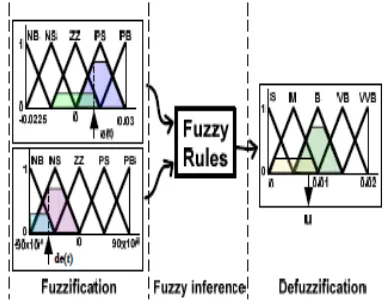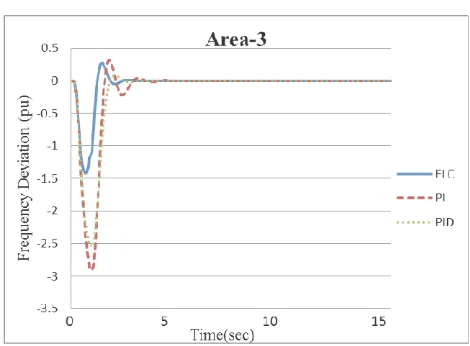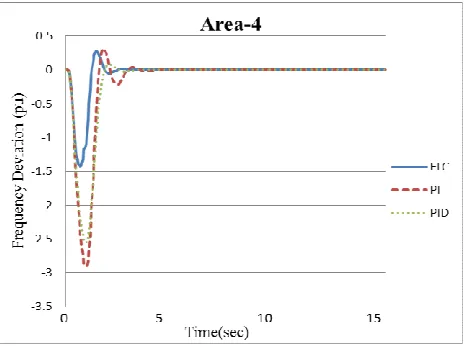2013 | IJEDR1301002 INTERNATIONAL JOURNAL OF ENGINEERING DEVELOPMENT AND RESEARCH | IJEDR
(All right reserved by www.ijedr.org) 13
Fuzzy Logic Based Automatic Load Frequency
Control of Multi-Area Power Systems
Rajesh Narayan Deo
Electrical and Electronics Engg.Sharda University Greater Noida, India rn.deo@sharda.ac.in
Shiva Pujan Jaiswal
Electrical and Electronics Engg.Sharda University Greater Noida, India shivapujan.jaiswal@sharda.ac.in
M. Venkateswarlu Naik
Electrical and Electronics Engg. National Institute of TechnologyCalicut, Kerala, India venkat.ramana228@gmail.com
Abstract— now days due to the increase in the interconnection of the power system, load as well as power flow in tie-line are varying dynamically. So there is a need of robust control of both systems frequency and tie-line power flows. This robust control can be attained using fuzzy logic controller rather than the conventional proportional, proportional integral and proportional integral derivative controllers. Because gain values of conventional controllers are constant, for load changes. Load can’t be constant, load changes time to time but gain values of conventional controllers are constant. In order to overcome the drawbacks of the conventional controllers, many techniques have been proposed in literature. In this work, fuzzy logic base controller is considered for load frequency control problem. The required rules are executed depending upon the load variation to minimize the error. In fuzzy logic controller, triangular membership function is used for making the rule base, because triangular membership function gives easy way to make the rule base compared to other membership functions. The system simulation is realized by using Matlab/Simulink software.
Index Terms— Automatic Load Frequency Control, PI, PID Fuzzy Logic Controller and Matlab/Simulink Software, AGC.
I.INTRODUCTION
In recent years, power systems have more complicated and Non-linear configurations. Many industrial establishments are affected by operating point variations [1]. Electricity sector and end user are concerned about power quality reliability, efficiency and energy future. There are many reasons about increasing concerns on power quality. The microprocessor based equipment and power electronic devices are more sensitive to power quality. On the other hand, an electric network consists of many interconnected subsystems. If a fault occurs in a subsystem, disturbances and interruptions adversely affecting power quality take place in the power system. Any disharmonies between energy generation and demand cause frequency deviations. Thus, significant frequency deviations lead to system blackouts [2]. Power system loads are usually variable so that controller system must be designed to provide power system quality. Interconnected power systems regulate
power flows and frequency by means of an automatic generation control (AGC). AGC is a feedback control system adjusting a generator output power to remain defined frequency [3]. AGC comprises a load frequency control (LFC) loop and an automatic voltage regulator (AVR) loop. LFC system provides generator load control via frequency [3]. Zero steady-state -errors of frequency deviations and optimal transient behavior are objectives of the LFC in a multi-area interconnected power
system [4]. So far there are many studies about load frequency control of interconnected power systems. The aim is a design of feedback controller to realize desired power flow and frequency in multi-area power systems.
In literature, control strategies based on conventional and fuzzy logic controller are proposed [5]. Several authors suggest variable-structure systems, various adaptive control techniques and Riccati equation approach for load a frequency controller design [6, 7]. There are many studies about different control strategies having advantages and disadvantages [1, 2, 5, 8-10]. In Reference [9], a load frequency control using a conventional PID controller is applied and it is emphasized that the controller performance is better than others. However, if a power system structure has nonlinear dynamics and parts, the system operating point varies and conventional controllers needing system model must not be used. In Reference [5], a modified dynamic neural networks controller is proposed. It is determined that the proposed controller offers better performance than conventional neural network controller. In Reference [2], for a single area system and two areas interconnected power systems, artificial intelligence techniques are purposed for the automatic generation control and the comparison is performed between intelligent controllers and the conventional PI and PID controllers. In Reference [10], a robust decentralized control strategy is used for Load frequency control for four area power systems to obtain robust stability and better performances. In References [1, 8], power system load frequency control is realized by fuzzy logic controller.
II.FOUR-AREAPOWERSYSTEM
2013 | IJEDR1301002 INTERNATIONAL JOURNAL OF ENGINEERING DEVELOPMENT AND RESEARCH | IJEDR
(All right reserved by www.ijedr.org) 14 connected to each other by tie lines and need controllability
of frequency and power flow [4]. Interconnected multiple-area power systems can be depicted by using circles. A simplified four area interconnected power system used in this study, each area can be represented as equivalent generating unit and interconnected through lossless tie-lines with some reactance. As simplified four-area interconnected power systems as shown in Fig. 1 [6].
Fig 1 Four-area electric power system with interconnections
In Fig. 2, a four-area interconnected system block diagram is depicted. The system frequency deviation Δ
fi, the
deviation inthe tie-line power flow ΔPtie,i, load disturbance ΔPDi. The system parameter values are given in Appendix.
Fig 2 Block diagram for one area of system (ith area)
A four-area electric power system is considered as a test system and shown in Figure 1. The block diagram for each area of interconnected areas is shown in Figure 2. The parameters in Figure 2 are defined as follows:
Where,
i = 1, 2, 3, 4. j = 1, 2, 3, 4 and i ≠ j Δ : Deviation from nominal value
Mi=2H : Constant of inertia of ith area Di: Damping constant of ith area
Ri : Gain of speed droop feedback loop of ith area Tti : Turbine Time constant of i
th area TGi : Governor Time constant of ith area Gi : Controller of ith area
ΔPDi : Load change of ith area
Bi=(1/Ri)+Di : Frequency bias factor of i th
area ΔPtie ij : Tie power interchange from ith area to jth area
III.FUZZYLOGICCONTROLLER
Since power system dynamic characteristics are complex and variable, conventional control methods cannot provide desired results. Intelligent controllers can be replaced with conventional controllers to get fast and good dynamic response in load frequency control problems [12]. If the system robustness and reliability are more important, fuzzy-logic controllers can be more useful in solving a wide range of control problems since conventional controllers are slower and also less efficient in nonlinear system applications [8, 13, 14]. Fuzzy logic controller is designed to minimize fluctuation on system outputs [15]. There are many studies on power system with fuzzy logic controller [16-18]. FLC designed to eliminate the need for continuous operator attention and used automatically to adjust some variables the process variable is kept at the reference value. A FLC consists of three sections namely, fuzzifier, rule base, and defuzzifier as shown in Fig 3.
Fig 3 Fuzzy inference system for FLC.
2013 | IJEDR1301002 INTERNATIONAL JOURNAL OF ENGINEERING DEVELOPMENT AND RESEARCH | IJEDR
(All right reserved by www.ijedr.org) 15 TABLEIFUZZYRULESDECISIONTABLEFORFLC
The main fuzzy reasoning blocks and the defuzzification process of the FLC used in this study are given in Fig. 4. The FLC used here is developed in Matlab/Simulink environment for multipurpose use as a control tool. With some simple modifications it can be used to control different systems. More detailed information about the Matlab/Simulink modeling of the FLC used here can be found in [19,20].
Fig 4 Fuzzy reasoning representing the process from fuzzification to defuzzification
IV.SIMULATIONRESULTS
The system dynamic performance is observed for three different controller structures, PI (Proportional + Integral), PID and Fuzzy logic controller. The simulation results are shown in Figs. 5-8 in this study.
Fig 5 Dynamic response of Area 1
Fig 6 Dynamic response of Area 2
2013 | IJEDR1301002 INTERNATIONAL JOURNAL OF ENGINEERING DEVELOPMENT AND RESEARCH | IJEDR
(All right reserved by www.ijedr.org) 16 Fig 8 Dynamic response of Area 4
V.CONCLUSION
In this paper, a fuzzy logic controller technique is designed for automatic load frequency control of four-area interconnected power systems. The system dynamic performances are observed via using different controllers.
REFERENCES
[1] I. Kocaarslan and E. Cam, “Fuzzy logic controller in interconnected electrical power systems for load-frequency control,” Electrical Power and Energy Systems, vol. 27, no. 8, pp. 542-549, 2005.
[2] V.D.M. Kumar, “Intelligent controllers for automatic generation control,” IEEE Region 10 International Conference on Global Connectivity in Energy, Computer, Communication and Control, TENCON ‘98, vol. 2, pp. 557-574, 1998. [3] A. Ismail, “Improving UAE power systems control
performance by using combined LFC and AVR,” The Seventh U.A.E. University Research Conference, ENG., pp. 50-60, 2006.
[4] C.S. Chang and W. Fu “Area load frequency control using fuzzy gain scheduling of PI controllers,” Electrical Power and Energy Systems, vol. 42, no. 2, pp. 145-152, 1997.
[5] K. Sabahi, M.A. Nekoui, M. Teshnehlab, M. Aliyari, and M. Mansouri, “Load frequency control in interconnected power system using modified dynamic neural networks,” Proceedings of the 15th Mediterranean Conference on Control & Automation, T26-011, 2007
[6] T.C. Yang, Z.T. Ding, and H. Yu, “Decentralised power system load frequency control beyond the limit of diagonal dominance,” Electrical Power and Energy Systems, vol. 24, no. 3, pp. 173-184, 2002.
[7] H. Cimen, “Decentralized load frequency controller design based on SSVs,” Turkish Journal of Electrical Engineering & Computer Sciences, vol. 8, no. 1, pp. 43-53, 2000.
[8] E. Cam and I. Kocaarslan, “Load frequency control in two area power systems using fuzzy logic controller,” Energy Conversion and Management, vol. 46, no. 2, pp. 233-243, 2005.
[9] A. Salami, S. Jadid, and N. Ramezani, “The Effect of load frequency controller on load pickup during restoration,” 1st International Power and Energy Conference, PECON 2006, pp. 225-228, 2006.
[10]H.S. Moghanlou and H.A. Shayanfar, “Robust decentralized LFC design in a restructured power system,” International Journal of Emerging Electric Power Systems, vol. 6. no. 2, Art. 4, 2006.
[11]J. Talaq and F. Al-Basri, “Adaptive fuzzy gain scheduling for load frequency control,” IEEE Transaction on Power Systems, vol. 14, no. 1, pp.145-150, 1999.
[12]H.D. Mathur and S. Ghosh, “A Comprehensive analysis of intelligent controllers for load frequency control,” IEEE Power India Conference, 10.1109/POWERI.2006.1632619, 2006.
[13]C.C. Lee, “Fuzzy logic in control systems: fuzzy logic controller-part I,” IEEE Transactions on Systems, Man. and Cybernetics, vol. 20, no. 2, pp. 404-418, 1990.
[14]C.C. Lee, “Fuzzy logic in control systems: fuzzy logic controller-part II,” IEEE Transactions on Systems, Man. and Cybernetics, vol. 20, no. 2, pp. 419-435, 1990.
2013 | IJEDR1301002 INTERNATIONAL JOURNAL OF ENGINEERING DEVELOPMENT AND RESEARCH | IJEDR
(All right reserved by www.ijedr.org) 17 [16]Y.H. Song and A.T. Johns, “Applications of fuzzy logic in
power systems: part 1 general introduction to fuzzy logic,” Power EngineeringJournal, pp. 219-222, 1997.
[17]Y.H. Song and A.T. Johns, “Applications of fuzzy logic in power systems: part 2 comparison and integration with expert systems, neural networks and genetic algorithms,” Power Engineering Journal, pp. 185-190, 1998.
[18]Y.H. Song and A.T. Johns, “Applications of fuzzy logic in power systems: part 3 example applications,” Power Engineering Journal, pp. 97-103, 1999.
[19]I.H. Altas and A.M. Sharaf, “Novel maximum power fuzzy logic controller for photovoltaic solar energy systems,” Renewable Energy,2007, doi:10.10 16/j.renene.2007.03.002, 2007.
[20]I.H. Altas and A.M. Sharaf, “A Generalized direct approach for designing fuzzy logic controllers in Matlab/Simulink GUI environment,” International Journal of Information Technology and Intelligent Computing, Int. J. IT&IC, vol.1, no.4, 2007.
APPENDIX
The typical values of system parameters for the nominal operating condition are as follows:
1st area parameters
TT1=0.03 TG1=0.08 M1=0.1667 R1=2.4 D1=0.0083 B1=0.401 T12=0.425 T13=0.500
The typical values of system parameters for the nominal operating condition are as follows:
1st area parameters
TT1=0.03 TG1=0.08 M1=0.1667 R1=2.4 D1=0.0083 B1=0.401 T12=0.425 T13=0.500 T14= 0.400
2nd area parameters
TT2=0.025 TG2=0.091 M2=0.1552 R2=2.1 D2=0.009 B2=0.300 T21=0.425 T23= 0.455 T24= 0.523
3rd area parameters
TT3=0.044 TG3=0.072 M3=0.178 R3=2.9 D3=0.0074 B3=0.480 T31=0.500T32= 0.455 T34=0.600
4th area parameters
TT4=0.033 TG4=0.085 M4=0.1500 R4=1.995 D4=0.0094 B4=0.3908 T41= 0.400 T42= 0.523 T43=0.600
Rajesh Narayan Deo received the M.Tech degree in Power systems from the NIT Calicut, has three year of industrial experience and currently working in Sharda University
.
His main fields of research are control of power Converters, Flexible AC Transmission systems and custom power devices.Shiva Pujan Jaiswal received the B.Tech and M.Tech degree in Electrical engineering from the DEI Agra, and currently working in Sharda University. His main fields of research are power system, Flexible AC Transmission systems.HVDC and renewable energy.


